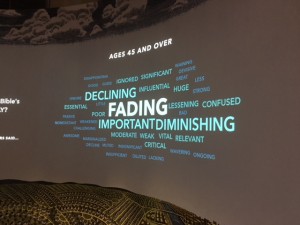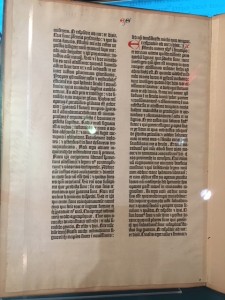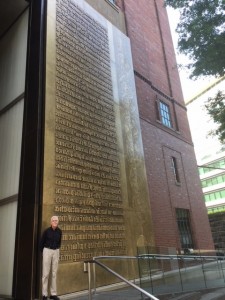The Bible has shaped the world in such fundamental ways that people are not fully aware of its pervasive influence on their lives.
Let’s imagine that you have never even opened the Bible. Does that mean you’re untouched by its influence? Not if you know what a “good Samaritan” is, or what the term “prodigal son” refers to, or who Adam and Eve are, or what kind of passengers Noah had in his ark, or what happened on the Cross, or a hundred other examples I could give.
Recently I had the opportunity to visit the Museum of the Bible that opened late last year in Washington, D.C. This is a world-class, interactive, multi-story museum just off the National Mall near some of the best museums in the country. Because of its prime location
and its stiff competition, this museum had to be good to be taken seriously, and in my opinion, it succeeds.
But why does the Bible need a museum in the first place? My own interest in the Museum of the Bible is particularly intense right now because I recently turned in the manuscript for my next book, which will be published by The Foundry Publishing (formerly Beacon Hill Press). My book focuses on the influence of the most famous New Testament passages on popular culture, literature, film, the church, and individual lives.
I spent two days at the Museum and was introduced to it by one of my Azusa Pacific University colleagues who serves as one of the consultants for it and who has helped shape it from its earliest days. I also got to meet some of the people who now run the Museum.
The Bible has reached a critical point in today’s world. It is still well-known, but is it as influential as it used to be? One floor of the Museum of the Bible is devoted to the impact the Bible has had on various aspects of culture throughout history, such as music, art, film, civil rights, education, and other areas. That section of the museum includes a poll that visitors can take about the Book’s influence in the past, present, and future.
The running results of those questions are displayed for visitors to see. One question is, “How would you describe the Bible’s impact on American HISTORY?” The most prominent answers are words like “Strong,” “Profound,” “Foundational,” and “Powerful.” In contrast, the most common answers to the question, “How would you describe the Bible’s impact on America TODAY?” are words like “Weak,” “Fading,” “Lacking,” and “Diminishing.”
impact on America TODAY?” are words like “Weak,” “Fading,” “Lacking,” and “Diminishing.”
Although people have doubts about the Bible’s current impact compared to earlier eras, some trends, such as the YouVersion Bible app that now has more than 250 million downloads all over the world, indicate that the Bible is more widely available than ever. Those trends seemed especially significant as I considered the Bible’s current wide availability in light of the Museum’s copies of Bibles from hundreds of years ago, before the printing press, when each page had to be copied by hand, making the Bible very rare indeed. In those days, most individuals could not own their own copy of the Bible, and even if they did, it would  probably be in Latin, a language most of the common people would not know. Still, even under those circumstances, the Bible had profound influence.
probably be in Latin, a language most of the common people would not know. Still, even under those circumstances, the Bible had profound influence.
The Museum also shows the Bible’s impact in areas where we might overlook it, such as popular music. One room features snippets of popular songs with biblical themes and allusions. The Adam and Eve theme shows up in songs from Elvis Presley, B.B. King, and Elvis Costello. The Moses/Exodustheme can be found in songs by Coldplay and Bob Marley. Psalm 23references can be heard in songs by Kanye West and Coolio, and so on.
Another display shows portions of countless films that have biblical subject matter, such as The Ten Commandments, History of the World Part I, Evan Almighty, and Noah.
Every art form imaginable has been influenced by the Bible. One display shows dozens of examples of the countless paintings of Jesus’ mother Mary, who for centuries was “the single most represented woman in the history of Western art.”
The Museum tries to entertain as well as educate, and one of my favorite parts is a section called the Hebrew Bible Experience. It is a multi-room, multimedia, multi-sensory experience that tells the story of the Hebrew Bible, more commonly called the Old Testament. It contains elements that dazzle, with lights, special effects, music, Moses’ burning bush, and other surprises, but it does more than offer a kind of theme-park ride. It also takes a text that for many readers is a confusing collection of laws, prophecy, history, and poetry and shows the storythat threads its way through it.
It is a story, starting with Adam and Eve, of the fall of humanity and the search for reconciliation with God. It is a story whose episodes include figures such as Abraham and Sarah, Isaac, Jacob, Moses, David, Ruth, and many others. Like the Museum itself, the Hebrew Bible Experience shows, through its memorable storytelling, why the Bible still grips people even in our distracted age and why it will no doubt continue to wield its influence in the decades to come.

Comments 6
Wow, sounds like an awesome place to visit & experience!…Seems like such a nice and different option while in D.C.
Thanks for sharing!!
Author
Thanks, Annia. I loved it!
Wow! I would love to visit The Bible Museum. Thanks for writing about it.
Author
Thank you! It is well worth seeing, especially if you’re planning a trip to the other great places in Washington, D.C.
Thanks so much for posting this article. I’ve not been there but have put it on my “must see” list. Have you visited “The Answers in Genesis Museum”? It too has a profound witness to thousands of visitors each year.
Author
I have not visited the museum that you mentioned. I think you would enjoy the Museum of the Bible. Hope you get to go someday!